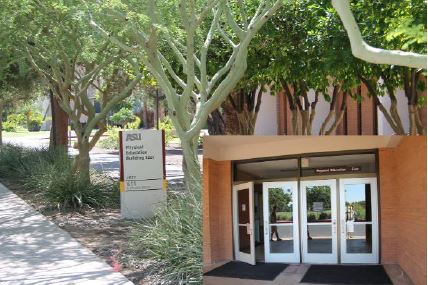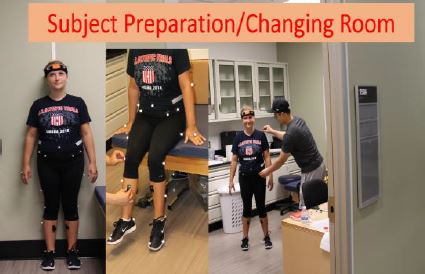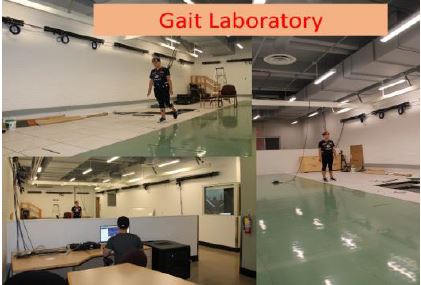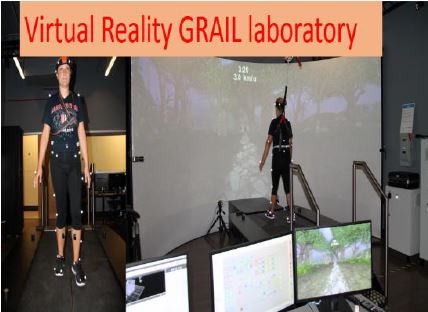
The Locomotion Research Labortory is located at the Physical Education Building East (PEBE) on the campus of Arizona State University at Tempe. The two-story building has office and collaboration spaces. The building features two laboratories, preparation or/ changing rooms, three conference rooms, numerous graduate student offices and student workstations. The shared-use facilities utilize more than 2000 sq. ft. of space that is configured for the development of rehabilitation technology and for neuromotor assessment in individuals with disabilities.

The laboratory has space and equipment to enable non-invasive measurements of biomechanical, neural control, metabolic and cardiorespiratory variables. The facility includes a gait lab that is equipped for kinematic and kinetic analysis of overground locomotion and has a ceiling-mounted low-friction harness system for safe perturbation experiments. One adjacent room houses the Motek Medical GRAIL system which consists of a dual-belt instrumented treadmill capable of delivering pitch, sway, and surge perturbations. The gait lab and the GRAIL treadmill space both have ceiling mounted harnesses for safety that also allow rigorous testing of situation when balance is compromised.

1) Gait Laboratory (approximately 20’ x 40’) – Only slightly smaller than the size of a basketball court with 24’ ceilings, this laboratory features two force plates (BertecCorporation), and Vicon Motion Analysis Corporation 3D digital motion capture system (10 cameras).

2) Virtual Reality laboratory – A 43’ x 29’ laboratory housing a rear-projection Virtual Reality system that is integrated with 3 Video Cameras and 10-Bonita Infra-red cameras with Vicon 3D digital motion capture system, and a Bertec instrumented split-belt treadmill. In addition, a wireless Delsys EMG system synchronized using D-Flow software from Motek Medical.
Major Equipment for the proposed project:
The Locomotion Research Labortory has all the equipment needed for the successful completion of various biomechanical projects. The Lab includes state-of-the-art laboratory equipment for virtually any biomechanics project available. All equipment is housed within the PEBE hall and the PI has immediate access to all equipment. Equipment specific to this project includes
following instruments:
– 3D motion-capture system: (VICON®, nexus, 3 video cameras and 10 Bonita camera, Oxford Metrics, Oxford, UK) that tracks the kinematics of whole body movement within the integration of kinetics. It can also provide real time (10ms delay) feedback to the kinematics of the markers.
– Instrumented split-belt treadmill: ; a dual-belt instrumented treadmill (GRAIL, Motek Medical BV, Amsterdam) with pitch (incline/decline), sway (medial/lateral), and surge (anterior/posterior) capabilities, immersive real-time video, and kinematic tracking; other treadmills.
– Xsens is 3D motion tracking technology and its sensor fusion technologies enable a seamless interaction between the physical and the digital and 3D character animation and motion analysis. Three Awinda stations for cahrginag and wireless transmission. The Awinda Station can receive data from up to 20 MTw’s simultaneously Data from multiple MTw’s is time-synchronized to within 10μs Charges up to 6 MTw’s simultaneously.
– Trigno™ Wireless Systems and Smart Sensors: 16 EMG channels, 48 accelerometer channels with 16-bit resolution, 1926 Hz EMG sampling rate with 8 hours of operation in full transmission mode.
– Jamar Grip Strength Dynamometer measures isometric grip force from 0–200 lbs (90 kg).
– AMTI’s AccuGait Optimized™ multi-axis force platform is a portable forceplate for quantifying human gait and balance. The AccuGait’s forceplate is accurate, economical, and easy to use with AMTI’s powerful NetForce software. It has plug & play USB interface which automatically synchronizes multiple platforms and eliminates external power supplies. AccuGait Optimized has unprecedented levels of accuracy for measuring Center of Pressure, forces and moments, as well as dramatic reductions in crosstalk.

